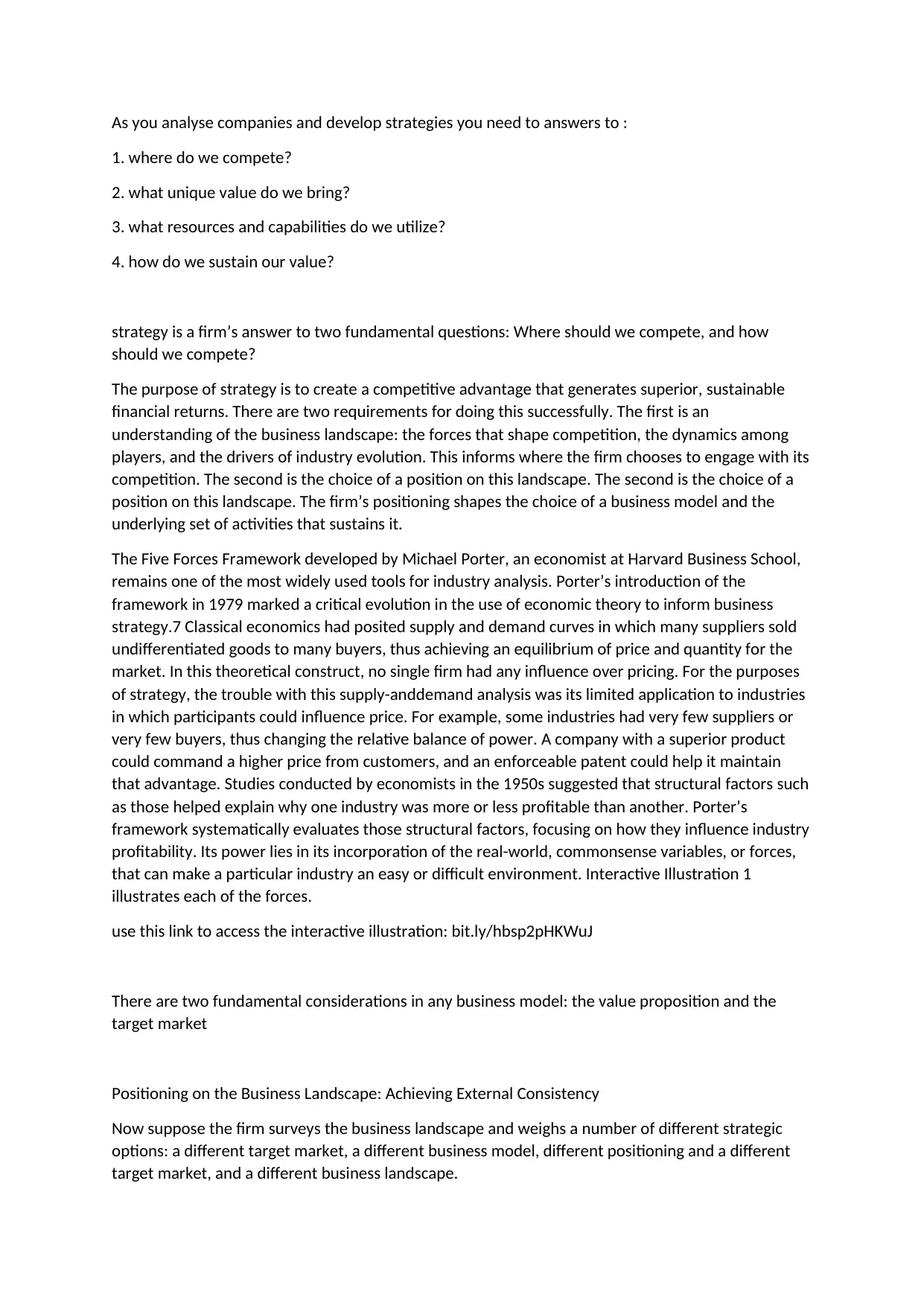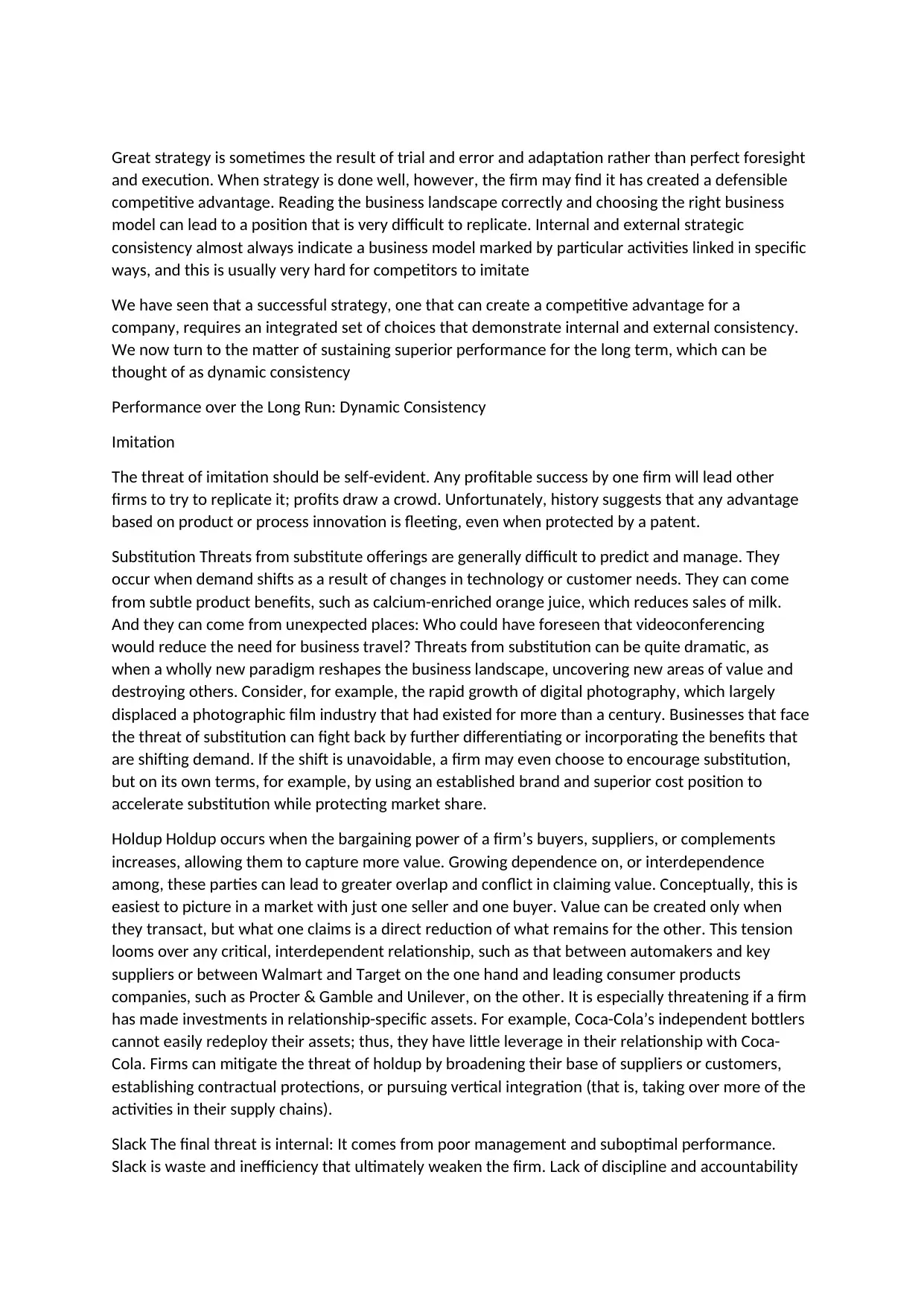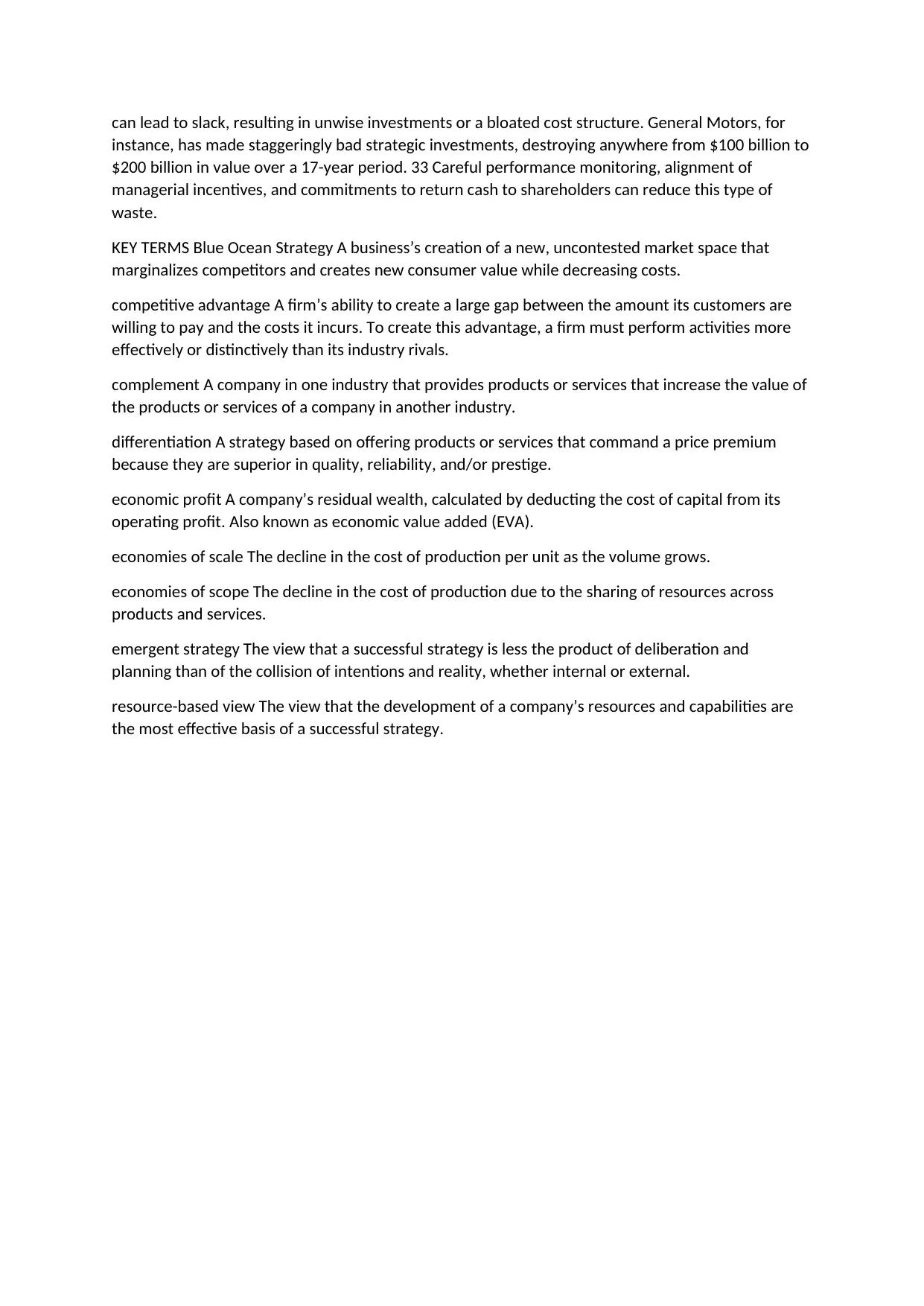Report on Business Strategy, Competitive Advantage, and Sustainability
VerifiedAdded on 2020/11/30
|3
|1474
|70
Report
AI Summary
This report provides a comprehensive analysis of business strategy, focusing on the creation and sustainability of competitive advantage. It begins by addressing fundamental strategic questions, such as where to compete and how to create unique value. The report explores the importance of understanding the business landscape, including industry forces and dynamics, using Michael Porter's Five Forces Framework as a key analytical tool. It examines the core components of a business model, including the value proposition and target market, and discusses the significance of strategic consistency, both internally and externally. Furthermore, the report delves into the long-term sustainability of competitive advantage, addressing threats such as imitation, substitution, holdup, and slack. Key terms such as 'Blue Ocean Strategy', 'competitive advantage', 'differentiation', and 'economic profit' are defined to provide a clear understanding of the concepts discussed. The report emphasizes the importance of strategic choices, consistent business models, and the ability to adapt to evolving business environments in order to achieve superior and sustainable financial returns.

As you analyse companies and develop strategies you need to answers to :
1. where do we compete?
2. what unique value do we bring?
3. what resources and capabilities do we utilize?
4. how do we sustain our value?
strategy is a firm’s answer to two fundamental questions: Where should we compete, and how
should we compete?
The purpose of strategy is to create a competitive advantage that generates superior, sustainable
financial returns. There are two requirements for doing this successfully. The first is an
understanding of the business landscape: the forces that shape competition, the dynamics among
players, and the drivers of industry evolution. This informs where the firm chooses to engage with its
competition. The second is the choice of a position on this landscape. The second is the choice of a
position on this landscape. The firm’s positioning shapes the choice of a business model and the
underlying set of activities that sustains it.
The Five Forces Framework developed by Michael Porter, an economist at Harvard Business School,
remains one of the most widely used tools for industry analysis. Porter’s introduction of the
framework in 1979 marked a critical evolution in the use of economic theory to inform business
strategy.7 Classical economics had posited supply and demand curves in which many suppliers sold
undifferentiated goods to many buyers, thus achieving an equilibrium of price and quantity for the
market. In this theoretical construct, no single firm had any influence over pricing. For the purposes
of strategy, the trouble with this supply-anddemand analysis was its limited application to industries
in which participants could influence price. For example, some industries had very few suppliers or
very few buyers, thus changing the relative balance of power. A company with a superior product
could command a higher price from customers, and an enforceable patent could help it maintain
that advantage. Studies conducted by economists in the 1950s suggested that structural factors such
as those helped explain why one industry was more or less profitable than another. Porter’s
framework systematically evaluates those structural factors, focusing on how they influence industry
profitability. Its power lies in its incorporation of the real-world, commonsense variables, or forces,
that can make a particular industry an easy or difficult environment. Interactive Illustration 1
illustrates each of the forces.
use this link to access the interactive illustration: bit.ly/hbsp2pHKWuJ
There are two fundamental considerations in any business model: the value proposition and the
target market
Positioning on the Business Landscape: Achieving External Consistency
Now suppose the firm surveys the business landscape and weighs a number of different strategic
options: a different target market, a different business model, different positioning and a different
target market, and a different business landscape.
1. where do we compete?
2. what unique value do we bring?
3. what resources and capabilities do we utilize?
4. how do we sustain our value?
strategy is a firm’s answer to two fundamental questions: Where should we compete, and how
should we compete?
The purpose of strategy is to create a competitive advantage that generates superior, sustainable
financial returns. There are two requirements for doing this successfully. The first is an
understanding of the business landscape: the forces that shape competition, the dynamics among
players, and the drivers of industry evolution. This informs where the firm chooses to engage with its
competition. The second is the choice of a position on this landscape. The second is the choice of a
position on this landscape. The firm’s positioning shapes the choice of a business model and the
underlying set of activities that sustains it.
The Five Forces Framework developed by Michael Porter, an economist at Harvard Business School,
remains one of the most widely used tools for industry analysis. Porter’s introduction of the
framework in 1979 marked a critical evolution in the use of economic theory to inform business
strategy.7 Classical economics had posited supply and demand curves in which many suppliers sold
undifferentiated goods to many buyers, thus achieving an equilibrium of price and quantity for the
market. In this theoretical construct, no single firm had any influence over pricing. For the purposes
of strategy, the trouble with this supply-anddemand analysis was its limited application to industries
in which participants could influence price. For example, some industries had very few suppliers or
very few buyers, thus changing the relative balance of power. A company with a superior product
could command a higher price from customers, and an enforceable patent could help it maintain
that advantage. Studies conducted by economists in the 1950s suggested that structural factors such
as those helped explain why one industry was more or less profitable than another. Porter’s
framework systematically evaluates those structural factors, focusing on how they influence industry
profitability. Its power lies in its incorporation of the real-world, commonsense variables, or forces,
that can make a particular industry an easy or difficult environment. Interactive Illustration 1
illustrates each of the forces.
use this link to access the interactive illustration: bit.ly/hbsp2pHKWuJ
There are two fundamental considerations in any business model: the value proposition and the
target market
Positioning on the Business Landscape: Achieving External Consistency
Now suppose the firm surveys the business landscape and weighs a number of different strategic
options: a different target market, a different business model, different positioning and a different
target market, and a different business landscape.
Paraphrase This Document
Need a fresh take? Get an instant paraphrase of this document with our AI Paraphraser

Great strategy is sometimes the result of trial and error and adaptation rather than perfect foresight
and execution. When strategy is done well, however, the firm may find it has created a defensible
competitive advantage. Reading the business landscape correctly and choosing the right business
model can lead to a position that is very difficult to replicate. Internal and external strategic
consistency almost always indicate a business model marked by particular activities linked in specific
ways, and this is usually very hard for competitors to imitate
We have seen that a successful strategy, one that can create a competitive advantage for a
company, requires an integrated set of choices that demonstrate internal and external consistency.
We now turn to the matter of sustaining superior performance for the long term, which can be
thought of as dynamic consistency
Performance over the Long Run: Dynamic Consistency
Imitation
The threat of imitation should be self-evident. Any profitable success by one firm will lead other
firms to try to replicate it; profits draw a crowd. Unfortunately, history suggests that any advantage
based on product or process innovation is fleeting, even when protected by a patent.
Substitution Threats from substitute offerings are generally difficult to predict and manage. They
occur when demand shifts as a result of changes in technology or customer needs. They can come
from subtle product benefits, such as calcium-enriched orange juice, which reduces sales of milk.
And they can come from unexpected places: Who could have foreseen that videoconferencing
would reduce the need for business travel? Threats from substitution can be quite dramatic, as
when a wholly new paradigm reshapes the business landscape, uncovering new areas of value and
destroying others. Consider, for example, the rapid growth of digital photography, which largely
displaced a photographic film industry that had existed for more than a century. Businesses that face
the threat of substitution can fight back by further differentiating or incorporating the benefits that
are shifting demand. If the shift is unavoidable, a firm may even choose to encourage substitution,
but on its own terms, for example, by using an established brand and superior cost position to
accelerate substitution while protecting market share.
Holdup Holdup occurs when the bargaining power of a firm’s buyers, suppliers, or complements
increases, allowing them to capture more value. Growing dependence on, or interdependence
among, these parties can lead to greater overlap and conflict in claiming value. Conceptually, this is
easiest to picture in a market with just one seller and one buyer. Value can be created only when
they transact, but what one claims is a direct reduction of what remains for the other. This tension
looms over any critical, interdependent relationship, such as that between automakers and key
suppliers or between Walmart and Target on the one hand and leading consumer products
companies, such as Procter & Gamble and Unilever, on the other. It is especially threatening if a firm
has made investments in relationship-specific assets. For example, Coca-Cola’s independent bottlers
cannot easily redeploy their assets; thus, they have little leverage in their relationship with Coca-
Cola. Firms can mitigate the threat of holdup by broadening their base of suppliers or customers,
establishing contractual protections, or pursuing vertical integration (that is, taking over more of the
activities in their supply chains).
Slack The final threat is internal: It comes from poor management and suboptimal performance.
Slack is waste and inefficiency that ultimately weaken the firm. Lack of discipline and accountability
and execution. When strategy is done well, however, the firm may find it has created a defensible
competitive advantage. Reading the business landscape correctly and choosing the right business
model can lead to a position that is very difficult to replicate. Internal and external strategic
consistency almost always indicate a business model marked by particular activities linked in specific
ways, and this is usually very hard for competitors to imitate
We have seen that a successful strategy, one that can create a competitive advantage for a
company, requires an integrated set of choices that demonstrate internal and external consistency.
We now turn to the matter of sustaining superior performance for the long term, which can be
thought of as dynamic consistency
Performance over the Long Run: Dynamic Consistency
Imitation
The threat of imitation should be self-evident. Any profitable success by one firm will lead other
firms to try to replicate it; profits draw a crowd. Unfortunately, history suggests that any advantage
based on product or process innovation is fleeting, even when protected by a patent.
Substitution Threats from substitute offerings are generally difficult to predict and manage. They
occur when demand shifts as a result of changes in technology or customer needs. They can come
from subtle product benefits, such as calcium-enriched orange juice, which reduces sales of milk.
And they can come from unexpected places: Who could have foreseen that videoconferencing
would reduce the need for business travel? Threats from substitution can be quite dramatic, as
when a wholly new paradigm reshapes the business landscape, uncovering new areas of value and
destroying others. Consider, for example, the rapid growth of digital photography, which largely
displaced a photographic film industry that had existed for more than a century. Businesses that face
the threat of substitution can fight back by further differentiating or incorporating the benefits that
are shifting demand. If the shift is unavoidable, a firm may even choose to encourage substitution,
but on its own terms, for example, by using an established brand and superior cost position to
accelerate substitution while protecting market share.
Holdup Holdup occurs when the bargaining power of a firm’s buyers, suppliers, or complements
increases, allowing them to capture more value. Growing dependence on, or interdependence
among, these parties can lead to greater overlap and conflict in claiming value. Conceptually, this is
easiest to picture in a market with just one seller and one buyer. Value can be created only when
they transact, but what one claims is a direct reduction of what remains for the other. This tension
looms over any critical, interdependent relationship, such as that between automakers and key
suppliers or between Walmart and Target on the one hand and leading consumer products
companies, such as Procter & Gamble and Unilever, on the other. It is especially threatening if a firm
has made investments in relationship-specific assets. For example, Coca-Cola’s independent bottlers
cannot easily redeploy their assets; thus, they have little leverage in their relationship with Coca-
Cola. Firms can mitigate the threat of holdup by broadening their base of suppliers or customers,
establishing contractual protections, or pursuing vertical integration (that is, taking over more of the
activities in their supply chains).
Slack The final threat is internal: It comes from poor management and suboptimal performance.
Slack is waste and inefficiency that ultimately weaken the firm. Lack of discipline and accountability

can lead to slack, resulting in unwise investments or a bloated cost structure. General Motors, for
instance, has made staggeringly bad strategic investments, destroying anywhere from $100 billion to
$200 billion in value over a 17-year period. 33 Careful performance monitoring, alignment of
managerial incentives, and commitments to return cash to shareholders can reduce this type of
waste.
KEY TERMS Blue Ocean Strategy A business’s creation of a new, uncontested market space that
marginalizes competitors and creates new consumer value while decreasing costs.
competitive advantage A firm’s ability to create a large gap between the amount its customers are
willing to pay and the costs it incurs. To create this advantage, a firm must perform activities more
effectively or distinctively than its industry rivals.
complement A company in one industry that provides products or services that increase the value of
the products or services of a company in another industry.
differentiation A strategy based on offering products or services that command a price premium
because they are superior in quality, reliability, and/or prestige.
economic profit A company’s residual wealth, calculated by deducting the cost of capital from its
operating profit. Also known as economic value added (EVA).
economies of scale The decline in the cost of production per unit as the volume grows.
economies of scope The decline in the cost of production due to the sharing of resources across
products and services.
emergent strategy The view that a successful strategy is less the product of deliberation and
planning than of the collision of intentions and reality, whether internal or external.
resource-based view The view that the development of a company’s resources and capabilities are
the most effective basis of a successful strategy.
instance, has made staggeringly bad strategic investments, destroying anywhere from $100 billion to
$200 billion in value over a 17-year period. 33 Careful performance monitoring, alignment of
managerial incentives, and commitments to return cash to shareholders can reduce this type of
waste.
KEY TERMS Blue Ocean Strategy A business’s creation of a new, uncontested market space that
marginalizes competitors and creates new consumer value while decreasing costs.
competitive advantage A firm’s ability to create a large gap between the amount its customers are
willing to pay and the costs it incurs. To create this advantage, a firm must perform activities more
effectively or distinctively than its industry rivals.
complement A company in one industry that provides products or services that increase the value of
the products or services of a company in another industry.
differentiation A strategy based on offering products or services that command a price premium
because they are superior in quality, reliability, and/or prestige.
economic profit A company’s residual wealth, calculated by deducting the cost of capital from its
operating profit. Also known as economic value added (EVA).
economies of scale The decline in the cost of production per unit as the volume grows.
economies of scope The decline in the cost of production due to the sharing of resources across
products and services.
emergent strategy The view that a successful strategy is less the product of deliberation and
planning than of the collision of intentions and reality, whether internal or external.
resource-based view The view that the development of a company’s resources and capabilities are
the most effective basis of a successful strategy.
⊘ This is a preview!⊘
Do you want full access?
Subscribe today to unlock all pages.

Trusted by 1+ million students worldwide
1 out of 3
Related Documents
Your All-in-One AI-Powered Toolkit for Academic Success.
+13062052269
info@desklib.com
Available 24*7 on WhatsApp / Email
![[object Object]](/_next/static/media/star-bottom.7253800d.svg)
Unlock your academic potential
Copyright © 2020–2025 A2Z Services. All Rights Reserved. Developed and managed by ZUCOL.





